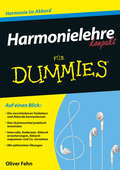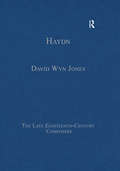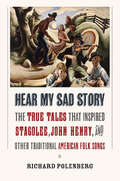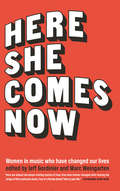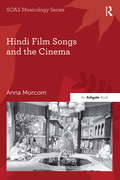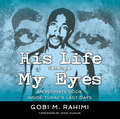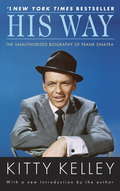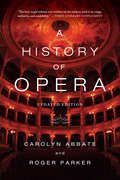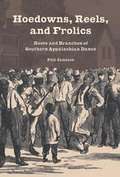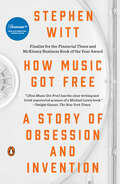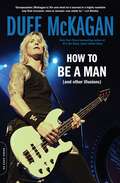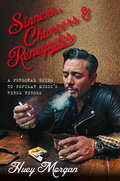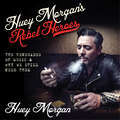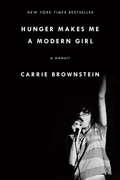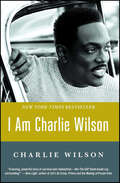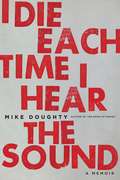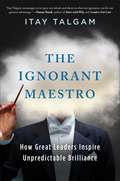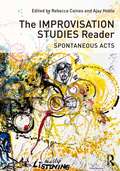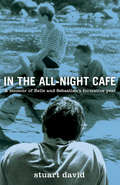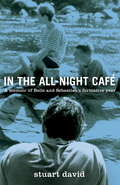- Table View
- List View
Harmonielehre kompakt für Dummies (Für Dummies)
by Oliver FehnFür Leichtigkeit und Kompetenz bei Intervallen und Kadenz So wohlklingend der Name auch ist – so unangenehm kompliziert kann die Harmonielehre für einen Musiker sein. Aber keine Sorge, Oliver Fehn erklärt Ihnen leicht verständlich alles, was Sie über die Lehre von den Akkorden wissen müssen. Sie erfahren zunächst alles Wichtige zu Tonleitern und warum man diese kennen muss, um Akkorde zu bilden. Anschließend werden Intervalle, Quintenzirkel und Co. besprochen und es wird intensiv auf die verschiedenen Akkorde, Akkorderweiterungen, Akkordsequenzen und Kadenzen eingegangen. Zahlreiche Übungen und Praxistipps runden das Buch ab.
Harmony in Chopin
by David DamschroderChopin's oeuvre holds a secure place in the repertoire, beloved by audiences, performers, and aesthetes. In Harmony in Chopin, David Damschroder offers a new way to examine and understand Chopin's compositional style, integrating Schenkerian structural analyses with an innovative perspective on harmony and further developing ideas and methods put forward in his earlier books Thinking about Harmony, Harmony in Schubert, and Harmony in Haydn and Mozart. Reinvigorating and enhancing some of the central components of analytical practice, this study explores notions such as assertion, chordal evolution (surge), collision, dominant emulation, unfurling, and wobble through analyses of all forty-three Mazurkas Chopin published during his lifetime. Damschroder also integrates analyses of eight major works by Chopin with detailed commentary on the contrasting perspectives of other prominent Chopin analysts. This provocative and richly detailed book will help transform readers' own analytical approaches.
Harrison Birtwistle Studies
by Beard, David and Gloag, Kenneth and Jones, Nicholas David Beard Kenneth Gloag Nicholas JonesThis collection of essays celebrates the work of Sir Harrison Birtwistle, one of the key figures in European contemporary music. Representing current research on Birtwistle's music, this book reflects the diversity of his work in terms of periods, genres, forms, techniques and related issues through a wide-range of critical, theoretical and analytical interpretations and perspectives. Written by a team of international scholars, all of whom bring a deep research-based knowledge and insight to their chosen study, this collection extends the scholarly understanding of Birtwistle through new engagements with the man and the music. The contributors provide detailed studies of Birtwistle's engagement with electronic music in the 1960s and 1970s, and develop theoretical explanations of his fascination with pulse, rhythm and time. They also explore in detail Birtwistle's interest in poetry, instrumental drama, gesture, procession and landscape, and consider the compositional processes that underpin these issues.
Haydn: Joseph Haydn And Britain (The\late Eighteenth-century Composers Ser.)
by DavidWyn JonesThis volume brings together a selection of the most stimulating and influential writing on Haydn and his music in the English language. Written by a range of established and younger scholars it probes a variety of aesthetic, biographical, compositional, performance and reception issues. A specially written introduction summarizes the significance of each essay, directs the reader to appropriate complementary material and seeks the common ground between the essays; to assist with consistent referencing the individual essays retain their original pagination. This representative compendium of Haydn research provides the opportunity to explore the intellectual diversity of recent scholarship and is an indispensable publication for students of Haydn, whether new or old, amateur or professional.
Hear My Sad Story: The True Tales That Inspired "Stagolee," "John Henry," and Other Traditional American Folk Songs
by Richard PolenbergIn 2015, Bob Dylan said, "I learned lyrics and how to write them from listening to folk songs. And I played them, and I met other people that played them, back when nobody was doing it. Sang nothing but these folk songs, and they gave me the code for everything that's fair game, that everything belongs to everyone." In Hear My Sad Story, Richard Polenberg describes the historical events that led to the writing of many famous American folk songs that served as touchstones for generations of American musicians, lyricists, and folklorists.Those events, which took place from the early nineteenth to the mid-twentieth centuries, often involved tragic occurrences: murders, sometimes resulting from love affairs gone wrong; desperate acts borne out of poverty and unbearable working conditions; and calamities such as railroad crashes, shipwrecks, and natural disasters. All of Polenberg's account of the songs in the book are grounded in historical fact and illuminate the social history of the times. Reading these tales of sorrow, misfortune, and regret puts us in touch with the dark but terribly familiar side of American history.On Christmas 1895 in St. Louis, an African American man named Lee Shelton, whose nickname was "Stack Lee," shot and killed William Lyons in a dispute over seventy-five cents and a hat. Shelton was sent to prison until 1911, committed another murder upon his release, and died in a prison hospital in 1912. Even during his lifetime, songs were being written about Shelton, and eventually 450 versions of his story would be recorded. As the song--you may know Shelton as Stagolee or Stagger Lee--was shared and adapted, the emotions of the time were preserved, but the fact that the songs described real people, real lives, often fell by the wayside. Polenberg returns us to the men and women who, in song, became legends. The lyrics serve as valuable historical sources, providing important information about what had happened, why, and what it all meant. More important, they reflect the character of American life and the pathos elicited by the musical memory of these common and troubled lives.
Here She Comes Now
by edited by Jeff Gordinier Marc WeingartenWhether it was Patti Smith's angry moan, Nina Simone's guttural growl, or Dolly Parton's towering hair and sweet voice, women have been a musical force to be reckoned with, inspired by, and paid attention to. In Here She Comes Now, today's biggest and brightest writers tackle their favorite female musicians and the effect they've had on their own lives. From Rosie Schaap writing about Sandy Denny to Susan Choi writing about Stevie Nicks to Elissa Schappell writing about Kim Gordon, Here She Comes Now thoughtfully and lovingly discusses the extreme badassery of the women who break through all the barriers to truly rock.
Hildegard of Bingen and Musical Reception
by Jennifer BainSince her death in 1179, Hildegard of Bingen has commanded attention in every century. In this book Jennifer Bain traces the historical reception of Hildegard, focusing particularly on the moment in the modern era when she began to be considered as a composer. Bain examines how the activities of clergy in nineteenth-century Eibingen resulted in increased veneration of Hildegard, an authentication of her relics, and a rediscovery of her music. The book goes on to situate the emergence of Hildegard's music both within the French chant restoration movement driven by Solesmes and the German chant revival supported by Cecilianism, the German movement to reform Church music more generally. Engaging with the complex political and religious environment in German speaking areas, Bain places the more recent Anglophone revival of Hildegard's music in a broader historical perspective and reveals the important intersections amongst local devotion, popular culture, and intellectual activities.
Hindi Film Songs and the Cinema
by Anna MorcomSince their beginnings in the 1930s, Hindi films and film songs have dominated Indian public culture in India, and have also made their presence felt strongly in many global contexts. Hindi film songs have been described on the one hand as highly standardized and on the other as highly eclectic. Anna Morcom addresses many of the paradoxes eccentricities and myths of not just Hindi film songs but also of Hindi cinema by analysing film songs in cinematic context. While the presence of songs in Hindi films is commonly dismissed aspurely commercial this book demonstrates that in terms of the production process, musical style, and commercial life, it is most powerfully the parent film that shapes and defines the film songs and their success rather than the other way round. While they constitute India‘s still foremost genre of popular music, film songs are also situational, dramatic sequences, inherently multi-media in style and conception. This book is uniquely grounded in detailed musical and visual analysis of Hindi film songs, song sequences and films as well as a wealth of ethnographic material from the Hindi film and music industries. Its findings lead to highly novel ways of viewing Hindi film songs, their key role in Hindi cinema, and how this affects their wider life in India and across the globe. It will be indispensable to scholars seeking to understand both Hindi film songs and Hindi cinema. It also forms a major contribution to popular music, popular culture, film music studies and ethnomusicology, tackling pertinent issues of cultural production, (multi-)media, and the cross-cultural use of music in Hindi cinema. The book caters for both music specialists as well as a wider audience.
His Life Through My Eyes
by Gobi M. RahimiGobi M. Rahimi spent Tupac Shakur's last eight months with him, serving as a co-producer and director for many of his music videos and short films. Along the way, he took behind-the-scenes photographs of Tupac in more relaxed, casual settings. Gobi's photos and words show a side of Tupac that is rarely seen, and humanizes a man who has since become a legend.
His Way
by Kitty Kelley#1 NEW YORK TIMES BESTSELLER * With a new Introduction by the author This is the book that Frank Sinatra tried--but failed--to keep from publication, and it's easy to understand why. This unauthorized biography goes behind the iconic myth of Sinatra to expose the well-hidden side of one of the most celebrated--and elusive--public figures of our time. Celebrated journalist Kitty Kelley spent three years researching government documents (Mafia-related material, wiretaps, and secret testimony) and interviewing more than 800 people in Sinatra's life (family, colleagues, law-enforcement officers, friends). The result is a stunning, often shocking exposé of a man as tortured as he was talented, as driven to self-destruction as he was to success. Featuring a new Introduction by the author, this fully documented, highly detailed biography--filled with revealing anecdotes--is the penetrating story of the explosively controversial and undeniably multitalented legend who ruled the entertainment industry for fifty years and continues to fascinate to this day. Praise for His Way "The most eye-opening celebrity biography of our time."--The New York Times "A compelling page-turner . . . Kitty Kelley's book has made all future Sinatra biographies virtually redundant."--Los Angeles Herald ExaminerFrom the Trade Paperback edition.
A History of Opera: The Last 400 Years
by Roger Parker Carolyn Abbate“The best single volume ever written on the subject, such is its range, authority, and readability.”—Times Literary Supplement Why has opera transfixed and fascinated audiences for centuries? Carolyn Abbate and Roger Parker answer this question in their “effervescent, witty” (Die Welt, Germany) retelling of the history of opera, examining its development, the musical and dramatic means by which it communicates, and its role in society. Now with an expanded examination of opera as an institution in the twenty-first century, this “lucid and sweeping” (Boston Globe) narrative explores the tensions that have sustained opera over four hundred years: between words and music, character and singer, inattention and absorption. Abbate and Parker argue that, though the genre’s most popular and enduring works were almost all written in a distant European past, opera continues to change the viewer— physically, emotionally, intellectually—with its enduring power.
The History of the Erard Piano and Harp in Letters and Documents, 1785-1959
by Robert Adelson Alain Roudier Jenny Nex Laure Barthel Michel Foussard Robert Adelson Alain Roudier Jenny Nex Laure BarthelSébastien Erard and the firm that carried his name are seminal in the history of musical instruments. Erard's inventions - especially the double escapement for the piano and the double-action for the harp - have had an enormous impact on instruments and musical life and are still at the foundation of piano and harp building today. The recently discovered archives of the Erard piano and harp building firm are perhaps the largest and most complete record of musical instrument making anywhere, containing never-before-published correspondence from musicians including Mendelssohn, Liszt and Fauré. These volumes present the archive's records and documents in two parts, the first relating to inventions, business, composers and performers and the second to the Erard family correspondence. In both the original French and with English translations, the documents offer fascinating insights into the musical landscape of Europe from the start of Erard's career in 1785 to the closure of the firm in 1959.
Hoedowns, Reels, and Frolics: Roots and Branches of Southern Appalachian Dance
by Phil JamisonIn Hoedowns, Reels, and Frolics, old-time musician and flatfoot dancer Philip Jamison journeys into the past and surveys the present to tell the story behind the square dances, step dances, reels, and other forms of dance practiced in southern Appalachia. These distinctive folk dances, Jamison argues, are not the unaltered jigs and reels brought by early British settlers, but hybrids that developed over time by adopting and incorporating elements from other popular forms. He traces the forms from their European, African American, and Native American roots to the modern day. On the way he explores the powerful influence of black culture, showing how practices such as calling dances as well as specific kinds of steps combined with white European forms to create distinctly "American" dances. From cakewalks to clogging, and from the Shoo-fly Swing to the Virginia Reel, Hoedowns, Reels, and Frolics reinterprets an essential aspect of Appalachian culture.
How Music Got Free
by Stephen Witt"What happens when an entire generation commits the same crime?"How Music Got Free is a riveting story of obsession, music, crime, and money, featuring visionaries and criminals, moguls and tech-savvy teenagers. It's about the greatest pirate in history, the most powerful executive in the music business, a revolutionary invention and an illegal website four times the size of the iTunes Music Store. Journalist Stephen Witt traces the secret history of digital music piracy, from the German audio engineers who invented the mp3, to a North Carolina compact-disc manufacturing plant where factory worker Dell Glover leaked nearly two thousand albums over the course of a decade, to the high-rises of midtown Manhattan where music executive Doug Morris cornered the global market on rap, and, finally, into the darkest recesses of the Internet.Through these interwoven narratives, Witt has written a thrilling book that depicts the moment in history when ordinary life became forever entwined with the world online -- when, suddenly, all the music ever recorded was available for free. In the page-turning tradition of writers like Michael Lewis and Lawrence Wright, Witt's deeply-reported first book introduces the unforgettable characters--inventors, executives, factory workers, and smugglers--who revolutionized an entire artform, and reveals for the first time the secret underworld of media pirates that transformed our digital lives.An irresistible never-before-told story of greed, cunning, genius, and deceit, How Music Got Free isn't just a story of the music industry--it's a must-read history of the Internet itself.
How to Be a Man: (and other illusions)
by Duff MckaganDuff McKagan is one of the most respected survivors in hard rock. In How to Be a Man, he shares the wisdom he gained on the path to superstardom--from his time with Guns N’ Roses and Velvet Revolver to getting sober after a life of hard living to achieving his personal American Dream of marrying a supermodel, raising a family, and experiencing what it’s like to be winked at by Prince. An interviewer’s favorite, McKagan’s wisdom has been sought out on everything from financial planning and relationships to surviving the summer festival circuit and escaping a military coup. Expanding on his popular weekly columns in Seattle Weekly, Playboy. com, and ESPN. com, McKagan equips readers with the knowledge they need to rock fatherhood, manage their money, and remain a good dude in spite of it all.
Huey Morgan's Rebel Heroes: The Renegades of Music & Why We Still Need Them
by Huey MorganThe defining sounds of popular music - blues, rock 'n' roll, punk, hip-hop - were shaped and driven by rebel voices: whether that was Robert Johnson and Billie Holiday in the 1920-40s, or the likes of Jimi Hendrix, Janis Joplin and Joe Strummer in the 1960s and 70s. Truly ground- and rule-breaking voices have been drowned out by pop-by-numbers acts in more recent years, and in Rebel Heroes, Huey Morgan investigates where music started to lose its soul, and why the lessons of those renegade spirits of yesteryear are still so vital. The book is steeped in Huey's love for, and knowledge of, music and is full of personal anecdotes and stories of some of the greatest musicians to have graced us with their talent.
Huey Morgans Rebel Heroes: The Renegades Of Music And Why We Still Need Them
by Huey MorganThe defining sounds of popular music - blues, rock 'n' roll, punk, hip-hop - were shaped and driven by rebel voices: whether that was Robert Johnson and Billie Holiday in the 1920s and 30s, or the likes of Hendrix, Janis Joplin and Joe Strummer in the 1960s and 70s. In more recent years those truly ground- and rule-breaking voices have been harder to hear, and in Sinners, Chancers & Renegades, Huey Morgan shines a spotlight on the rebel spirits of music in the last century and looks at why there are so few around today. The book includes personal anecdotes from Huey of his experiences listening to these artists as a child, and of meeting - and in some cases playing with - some of them as a musician himself in later years.
Huey Morgan's Rebel Heroes: The Renegades of Music & Why We Still Need Them
by Huey MorganThe defining sounds of popular music - blues, rock 'n' roll, punk, hip-hop - were shaped and driven by rebel voices: whether that was Robert Johnson and Billie Holiday in the 1920-40s, or the likes of Jimi Hendrix, Janis Joplin and Joe Strummer in the 1960s and 70s. Truly ground- and rule-breaking voices have been drowned out by pop-by-numbers acts in more recent years, and in Rebel Heroes, Huey Morgan investigates where music started to lose its soul, and why the lessons of those renegade spirits of yesteryear are still so vital. The book is steeped in Huey's love for, and knowledge of, music and is full of personal anecdotes and stories of some of the greatest musicians to have graced us with their talent.(p) 2015 Octopus Publishing Group
Hunger Makes Me a Modern Girl: A Memoir
by Carrie Brownstein<P>From the guitarist of the pioneering band Sleater-Kinney, the book Kim Gordon says "everyone has been waiting for" -- a candid, funny, and deeply personal look at making a life--and finding yourself--in music. <P>Before Carrie Brownstein became a music icon, she was a young girl growing up in the Pacific Northwest just as it was becoming the setting for one the most important movements in rock history. <P> Seeking a sense of home and identity, she would discover both while moving from spectator to creator in experiencing the power and mystery of a live performance. <P>With Sleater-Kinney, Brownstein and her bandmates rose to prominence in the burgeoning underground feminist punk-rock movement that would define music and pop culture in the 1990s. <P>They would be cited as "America's best rock band" by legendary music critic Greil Marcus for their defiant, exuberant brand of punk that resisted labels and limitations, and redefined notions of gender in rock. <P>HUNGER MAKES ME A MODERN GIRL is an intimate and revealing narrative of her escape from a turbulent family life into a world where music was the means toward self-invention, community, and rescue. <P>Along the way, Brownstein chronicles the excitement and contradictions within the era's flourishing and fiercely independent music subculture, including experiences that sowed the seeds for the observational satire of the popular television series Portlandia years later. <P>With deft, lucid prose Brownstein proves herself as formidable on the page as on the stage. <P>Accessibly raw, honest and heartfelt, this book captures the experience of being a young woman, a born performer and an outsider, and ultimately finding one's true calling through hard work, courage and the intoxicating power of rock and roll.
I Am Charlie Wilson
by Charlie WilsonThe long-awaited New York Times bestselling memoir of seven-time Grammy-nominated artist Charlie Wilson, the iconic R&B and Funk singer-songwriter-producer and former lead singer of The Gap Band—interwoven with his recollections of collaborating with fellow artists such as Stevie Wonder, Kanye West, and Snoop Dogg.Recognized the world over for his distinct voice and timeless hits spanning a career of nearly half a century, Charlie Wilson is one of the most celebrated musicians of his generation. So it took friends and family by surprise when he checked into rehab and revealed that he had been not only homeless, but also helpless.Here is the riveting story of how love and faith carried him through not only his addiction, but also prostate cancer. Here, too, is the story of his work in the music business, including a career resurgence that saw collaborations with some of the most sought-after artists of today, including Pharrell and Justin Timberlake.Now over twenty years sober, Wilson recounts a life filled with vertiginous highs and heartbreaking lows. His is a story of triumph over adversity, courage in the face of extreme hardship, and love when all else is lost. It is a tale of the last sixty years in social and pop culture history, and one that will stay with you for years to come.
I Die Each Time I Hear the Sound: A Memoir
by Mike DoughtyA precise yet disorienting look at the exhilaration of music, the process of memory, and the moments when the world becomes new, by the acclaimed songwriter and author of The Book of Drugs "[Mike Doughty's writing is] astonishingly vital, energized, and natural. . . . acerbic and sometimes lacerating."--RICK MOODY, author of The Long Accomplishment and The Ice Storm In this highly original gathering of autobiographical stories, the musician and writer Mike Doughty, in his inimitable voice, sends dispatches from a touring musician's peripatetic life, vividly recalling moments when profound musical experiences made him see the world anew.I Die Each Time I Hear the Sound consists of sometimes-surreal tales, drawing from conflations of memory, especially formative moments in New York City in the 1990s. It looks at how the avid nostalgia of fans is both a boon and a burden for an artist working to stay vital, and what it is to age while touring, and prolifically releasing new music. He examines the struggle to keep relationships alive while living on the road, and the strangeness of the disconnect between performer and audience. A unique narrative, unstuck in time, and an unforgettable examination of what it is to be an artist in this cultural moment, I Die Each Time I Hear the Sound is funny, vulnerable, and unsparing.
The Ignorant Maestro
by Itay Talgam"Choosing ignorance might seem a terrible quality to exhibit in your workplace--a sure path down the stairs and out the corporate door. But stick with me here and see how it leads you upward. You'll understand why great leaders embrace ignorance and use it to elevate their people to new heights of achievement."A conductor in front of his orchestra is an iconic symbol of leadership--but what does a true maestro actually do to enable the right sort of cooperation among his players, leading to an excellent performance? If you think his primary job is making sure the musicians play the right notes, prepare to be surprised.For twenty years, in addition to conducting orchestras around the world, Itay Talgam has been a "conductor of people" for companies large and small, for CEOs of Fortune 500 companies as well as startup entrepreneurs, and beyond. Drawing on his decades of experience on the podium, he teaches nonmusicians how conducting really works and how the conductor's art can help leaders in any field.In his lectures (including an acclaimed TED talk) and now in this book, Talgam shows why imposing your vision on your people is likely to backfire. Great conductors may know in advance how they want a piece to be played, but they make room for the creativity and passion of their musicians. They respect the gap between the baton and the instruments. They focus more on listening than on speaking. And they embrace their own ignorance, knowing that others may have better ideas than the conductor can imagine.Talgam explores the nuances of leadership by describing the distinctive styles of six world-famous conductors: the commanding Riccardo Muti, the fatherly and passionate Arturo Toscanini, the calm Richard Strauss, the gurulike Herbert von Karajan, the dancing Carlos Kleiber, and the master of dialogue Leonard Bernstein. All took different approaches to the age-old leadership dilemma: how to maximize both control and creative freedom at the same time.The Ignorant Maestro will empower you to help your own team make even more beautiful music. Talgam's anecdotes and insights will change the way you think about listening, humility, and the path to unpredictable brilliance.From the Hardcover edition.
The Improvisation Studies Reader: Spontaneous Acts
by Ajay Heble Rebecca CainesImprovisation is a performance practice that animates and activates diverse energies of inspiration, critique, and invention. In recent years it has coalesced into an exciting and innovative new field of interdisciplinary scholarly inquiry, becoming a cornerstone of both practical and theoretical approaches to performance. The Improvisation Studies Reader draws together the works of key artists and thinkers from a range of disciplines, including theatre, music, literature, film, and dance. Divided by keywords into eight sections, this book bridges the gaps between these fields. The book includes case studies, exercises, graphic scores and poems in order to produce a teaching and research resource that identifies central themes in improvisation studies. The sections include: Listening Trust/Risk Flow Dissonance Responsibility Liveness Surprise Hope Each section of the Reader is introduced by a newly commissioned think piece by a key figure in the field, which opens up research questions reflecting on the keyword in question. By placing key theoretical and classic texts in conversation with cutting-edge research and artists’ statements, this book answers the urgent questions facing improvising artists and theorists in the mediatized Twenty-First Century.
In the All-Night Café: A Memoir of Belle and Sebastian's Formative Year
by Stuart DavidBelle and Sebastian have been making music to critical acclaim since their formation in 1996. They have played hundreds of gigs and won a Brit Award; their music has been featured in popular films; and their unsettling, often surreal songs, delicate melodies, and alternative approach to pop stardom have earned them fans worldwide. In the All-Night Café is founding member Stuart David's charming and evocative memoir of Belle and Sebastian's first year, an as-yet-undocumented period of the band's history. Beginning with the fortuitous meeting of Stuart Murdoch and Stuart David at a course for unemployed musicians in Glasgow, it tells--in David's eminently readable and understated style--of their adventures in two early incarnations of Belle and Sebastian, culminating in the recording of the band's much-loved and highly praised debut album, Tigermilk. But this is not just a book for Belle and Sebastian fans: it's a universal story about being young, out of work, and trying to make something of your life--about discovering something you love, being fortunate enough to find similarly minded people, and making a go of it.
In the All-Night Café
by Stuart DavidOne afternoon, in 1994, I had an idea. So begins Stuart David's magical, evocative memoir about Belle and Sebastian. Determined to make his living writing stories and songs, Stuart had spent several years scraping by on the dole in his small, industrial home town. Then he had the fateful idea to learn bass guitar, and to head for Glasgow in search of like-minded artists. It was a quiet but powerful idea that would completely transform his life. Within one extraordinary year he had helped create one of the most influential, beloved bands of all time. Set against a vivid background of early 90s Glasgow, In the All-Night Caf? describes Stuart's fortuitous meeting with the band's co-founder Stuart Murdoch on a course for unemployed musicians. It tells of their adventures in two early incarnations of Belle and Sebastian and culminates in the recording of the band's celebrated debut album, Tigermilk. A fascinating portrait of the group and its origins, it is also a story that will resonate with anyone who has put together - or thought of putting together - a band. It is a story of a group of friends who wanted to create a different kind of band and a different kind of music. And how - against all expectations - they succeeded. Written with wit, affection and a novelist's observant eye, In the All-Night Caf? brings to life the music and the early days of this most enigmatic and intriguing of bands.
